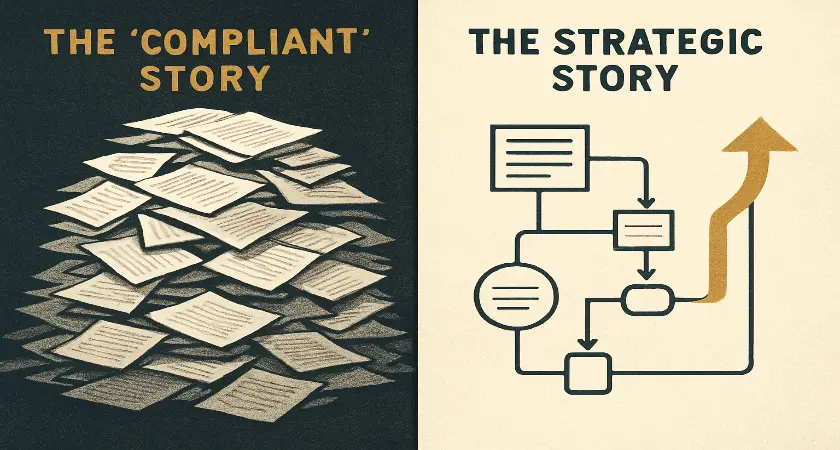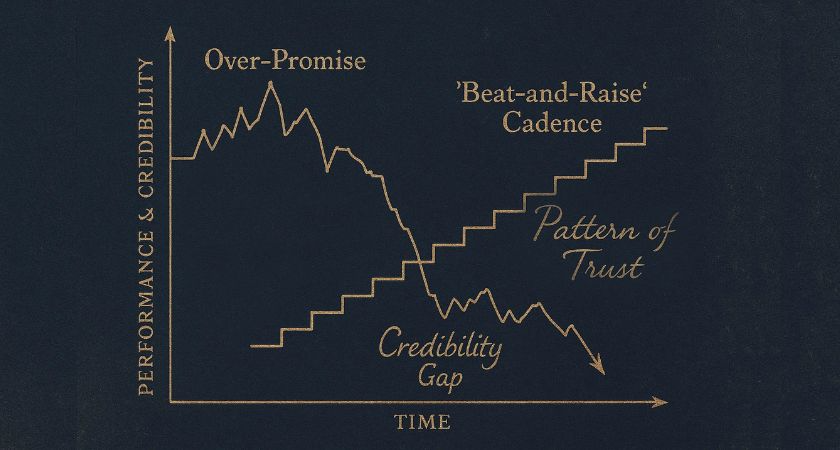You’ve hit your numbers three quarters running. Your SEC filings are spotless. Your earnings calls are professional, your management team is well prepared. Yet your stock price remains frustratingly flat—or worse, declining—while competitors with weaker fundamentals command premium valuations.
Here’s the uncomfortable truth: your “compliant” investor relations might be the very reason your stock is consistently undervalued, not “misunderstood” investors.
Your ‘Compliant’ IR Might Be Costing You Millions
Most CEOs operate under a dangerous assumption: that having an IR team, fulfilling regulatory compliance, and maintaining basic communication means their investor relations are effective. They tick the boxes—SEC filings submitted on time, earnings calls scheduled quarterly, press releases distributed properly—and assume the market will reward strong fundamentals.
The reality is far more costly.
After twenty years sitting across the table from public company management teams as an institutional investor, I’ve watched countless companies with impeccable compliance records see their stock prices stagnate or slide. These weren’t companies with accounting irregularities or governance scandals. They were operationally sound businesses whose leadership teams genuinely believed their “by-the-book” approach would eventually pay off.
It never did.
The hidden costs of this compliance-first mentality are staggering:
- Valuation discounts of 20-40% compared to peers with strategic narratives
- Increased volatility as confused investors trade on uncertainty rather than conviction
- Limited access to capital when growth opportunities arise
- Board pressure that escalates as quarters pass without valuation improvement
- Management credibility erosion that compounds with each disappointing market reaction
The most damaging aspect? CEOs often blame “irrational markets” or “shortsighted investors” rather than examining whether their communication strategy is fundamentally flawed. But sophisticated institutional investors aren’t irrational—they’re responding precisely to the signals you’re sending, even when those signals aren’t intentional.
The real risk isn’t missing a compliance deadline. It’s failing to capture and sustain an investor’s imagination and long-term confidence.
The Market Isn’t ‘Missing’ Your Value; They’re Responding to Your Story
Here’s where most CEOs get it wrong: they assume the problem is investor education. “If only they understood our business model,” they tell themselves. “If we could just get them to see our total addressable market.”
This mindset is backwards.
The market isn’t missing your value—they’re responding precisely to the story you’re telling them, whether you realize you’re telling it or not. And most companies are unknowingly telling a story of uncertainty, inconsistency, and unrealistic expectations.
Sophisticated investors don’t just buy numbers; they invest in believable, disciplined narratives backed by consistent execution. They’ve seen countless companies over-promise and under-deliver. They’ve watched management teams get seduced by aggressive projections that create impossible-to-maintain growth expectations. They’ve learned to spot the warning signs of narrative inconsistency that precede major disappointments.
What Wall Street actually rewards:
- Predictable execution against conservative, achievable guidance
- Transparent communication about challenges before they become crises
- Disciplined capital allocation that prioritizes sustainable growth over flashy acquisitions
- Consistent messaging across all investor touchpoints
Most traditional IR approaches fall catastrophically short of these requirements. The “Big Four” consulting firms and large outsourced IR providers focus heavily on compliance and process—necessary foundations, but minimum requirements, not drivers of valuation. They often encourage aggressive targeting and lofty projections that sound compelling in pitch decks but create credibility disasters when reality sets in.
Generic IR firms lack the strategic depth needed for true narrative engineering. They know how to write press releases and organize roadshows, but they don’t understand the psychology of the investor sitting across the table. They can’t teach you how to set guidance that builds rather than destroys long-term credibility.
The fundamental shift required: Stop trying to convince investors your company is undervalued and start building the consistent, disciplined communication pattern that earns premium valuations over time.
The Insider’s Edge: Mastering Investor Psychology & Consistent Credibility
This is where experience on both sides of the table becomes invaluable. Having spent twenty years as an institutional investor before becoming an SVP of Finance and Investor Relations at a public company, I don’t just theorize about what investors want—I know how they think, because I’ve been them.
Winning consistent credibility with the market starts with mastering three key dynamics of investor psychology—what I call the insider’s edge:
1. The Investor’s Mindset: Why Knowing What They ‘Get’ Changes Everything
In one buy-side meeting I attended, a promising tech company lost a room full of investors in minutes—not because their fundamentals were bad, but because the CEO dodged two simple questions about margin sustainability. Trust was gone—and so was future demand for the stock.
When you’ve sat in hundreds of management presentations, participated in countless due diligence sessions, and made buy-and-sell decisions with real money on the line, you develop an intuitive understanding of investor psychology that can’t be learned from textbooks or consulting frameworks.
Investors are pattern-recognition machines. They’re looking for signals of management credibility, business predictability, and narrative consistency. They can sense when a CEO is overselling or when guidance is based on hope rather than disciplined analysis. They know the difference between companies that understand their own economics and those that are still figuring it out.
This insider perspective reveals critical truths that most IR approaches miss entirely:
- Investors prefer conservative guidance they can trust over aggressive targets that create anxiety
- They value management teams that acknowledge risks upfront rather than discovering them in quarterly surprises
- They invest based on their confidence in your ability to execute, not your ability to project
We don’t just tell you what investors want; we show you how they think, because we’ve been there—and we know exactly how they decide which stocks to buy, hold, or sell.
2. The “Beat-and-Raise” Cadence: The Wall Street Game Changer
The most powerful tool in strategic investor relations is also the most misunderstood: the disciplined “beat-and-raise” cadence. This isn’t about sandbagging or lowballing expectations. It’s about setting conservative but achievable guidance and consistently exceeding it, creating a pattern of positive surprises that builds unshakeable investor confidence.
Here’s why this strategy transforms valuations:
Wall Street doesn’t reward bold projections; it rewards consistency and credibility. When you establish a track record of beating guidance by 2-3% each quarter and raising forward estimates based on demonstrated momentum, you train the market to expect positive surprises. This expectation gets built into your valuation multiple.
The beat-and-raise methodology:
- Set guidance sufficiently below your internal expectations based on conservative assumptions that you can comfortably beat those numbers
- Communicate the key variables that could drive upside without committing to specific outcomes
- Beat that guidance consistently while highlighting sustainable drivers of the outperformance
- Raise guidance incrementally based on demonstrated results, not projected hope
- Repeat quarterly until the market recognizes your disciplined approach
This creates a virtuous cycle: consistent execution builds credibility, credibility reduces perceived risk, lower risk drives higher valuation multiples, and higher multiples provide more strategic flexibility for growth investments.
The companies that master this approach don’t just survive market volatility—they thrive during uncertainty because investors trust their ability to navigate challenges and deliver on commitments.
3. Beyond the Pitch Deck: Winning the Roadshow & Earnings Call
Having prepared for investor meetings from both sides—as the investor asking tough questions and as the executive fielding them—I know that real preparation involves rigorous Q&A coaching, not just polishing slides.
You get one shot to make your story stick, and investors can tell when you’re bluffing. Effective roadshow preparation is 80% advanced Q&A training, not slide refinement. The questions that matter aren’t the ones you hope they’ll ask—they’re the ones you’re terrified they will ask.
The insider advantage means we know:
- Which questions reveal management depth versus superficial preparation
- How to handle skeptical follow-ups without sounding defensive
- When to acknowledge uncertainty honestly versus when to demonstrate conviction
- How to pivot challenging questions back to your strategic narrative
I once coached a CEO whose opening pitch was flawless—but he stumbled when asked about a competitive threat we had pre-identified. One rehearsed pivot later, he regained control of the meeting and won back trust.
This dual perspective—investor and operator—provides the playbook for transforming your highest-stakes communications from nerve-wracking ordeals into competitive advantages.
Arm Yourself: The Definitive Case for Strategic IR
If you’re reading this and recognizing your company’s situation, you’re likely facing internal resistance to change. Your IR team might feel threatened by external expertise. Your CFO might question the budget allocation. Your calendar might seem too packed for another strategic initiative.
Here’s the argument that wins every time:
This isn’t an additional cost; it’s the most undervalued lever for your company’s long-term valuation and market credibility. Consider the math: a 10% improvement in your valuation multiple—easily achievable through strategic investor relations—likely represents hundreds of millions in market cap. What other initiative offers that kind of return on investment?
Address the objections head-on:
“Our internal team handles IR fine.”
Answer: Your internal team is capable, but they haven’t sat on the buy-side for twenty years. They know the mechanics of investor relations, but they don’t know the psychology of institutional investment decision-making.
“We don’t have time for another consulting engagement.”
Answer: Strategic IR isn’t about adding meetings to your calendar—it’s about making the meetings you already have dramatically more effective. One properly positioned earnings call can move your stock more than months of traditional IR activities.
“The budget impact is significant.”
Answer: The opportunity cost of maintaining a “good enough” approach is far greater. Every quarter you delay implementing strategic investor relations is another quarter of missed valuation potential, increased stock volatility, and strained investor relationships.
The strategic case is simple: You’ve built a strong business. You’ve assembled a capable team. You’ve delivered consistent results. The final piece—the piece that transforms operational success into market recognition—is strategic investor relations executed with an insider’s understanding of what actually drives investment decisions.
The cost of inaction compounds quarterly. Your competitors who master this discipline aren’t just communicating better—they’re accessing capital more easily, attracting higher-quality investors, and commanding premium valuations that provide strategic flexibility you’re currently missing.
This is your opportunity to close the gap between your company’s intrinsic value and its market valuation. The question isn’t whether you can afford to invest in strategic investor relations. The question is whether you can afford not to.
Ready to transform your company’s investor relations?
Schedule a confidential strategic consultation with Jason Gold today.




